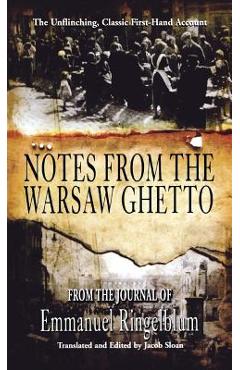Notes from the Warsaw Ghetto - Emmanuel Ingelblum

Detalii Notes from the Warsaw Ghetto
libris.ro
231.14 Lei
288.92 Lei
History
Emmanuel Ingelblum
Notes from the Warsaw Ghetto - Disponibil la libris.ro
Pe YEO găsești Notes from the Warsaw Ghetto de la Emmanuel Ingelblum, în categoria History.
Indiferent de nevoile tale, Notes from the Warsaw Ghetto - Emmanuel Ingelblum din categoria History îți poate aduce un echilibru perfect între calitate și preț, cu avantaje practice și moderne.
Preț: 231.14 Lei
Caracteristicile produsului Notes from the Warsaw Ghetto
- Brand: Emmanuel Ingelblum
- Categoria: History
- Magazin: libris.ro
- Ultima actualizare: 15-12-2024 01:42:32
Comandă Notes from the Warsaw Ghetto Online, Simplu și Rapid
Prin intermediul platformei YEO, poți comanda Notes from the Warsaw Ghetto de la libris.ro rapid și în siguranță. Bucură-te de o experiență de cumpărături online optimizată și descoperă cele mai bune oferte actualizate constant.
Descriere magazin:
Notes from the Warsaw Ghetto is the moving account of the horror of the Warsaw Ghetto-written by the recognized archivist and historian of the area while he lived through it. Through anecdotes, stories, and notations-some as brief as was slapped today in Zlota Street-there emerges the agonizing, eyewitness accounts of human beings caught in the furor of senseless, unrelenting brutality. In the Journal, there is the whole of life in the Ghetto, from the erection of the Wall, in November 1940, for hygienic reasons, through the brief period of deceptive calm to the eventual mass murders. It is a portrait of man tested by crisis, stained at times by the meanness of avarice and self-preservation, illumined more often by moments of nobility. Language Notes: English, Yiddish (translation) Emmanual Ringelblum was 39 when he began his notes. When the Germans first invaded Poland, Ringelblum, who could have stayed abroad and escaped, returned to Warsaw from Switzerland knowing that his was an historical event of importance for his people and a moment in time that must be forever a part of written history. As the recognized archivist of the Ghetto he gathered around him a staff, and assigned each to cover a specific part of Ghetto life. From these reports and this notes, he assembled his Journal. On March 7, 1944, Emmanual Ringelblum was executed among the ruins of Warsaw, together with his wife, his son, and thirt-eight others who shared his hiding place.

Produse asemănătoare

Heart of the Home: Notes from a Vineyard Kitchen 30th Anniversary Edition - Susan Branch
![]() libris.ro
libris.ro
Actualizat in 28/10/2025
161.54 Lei

Notes from Underground: Zines and the Politics of Alternative Culture - Stephen Duncombe
![]() libris.ro
libris.ro
Actualizat in 28/10/2025
111.32 Lei

Notes on Directing: 130 Lessons in Leadership from the Director\'s Chair - Frank Hauser
![]() libris.ro
libris.ro
Actualizat in 28/10/2025
121.02 Lei

The Message Devotional Bible: Featuring Notes & Reflections from Eugene H. Peterson - Eugene H. Peterson
![]() libris.ro
libris.ro
Actualizat in 28/10/2025
139.45 Lei

Field Notes for Food Adventure: Recipes and Stories from the Woods to the Ocean - Brad Leone
![]() libris.ro
libris.ro
Actualizat in 28/10/2025
195.3 Lei

